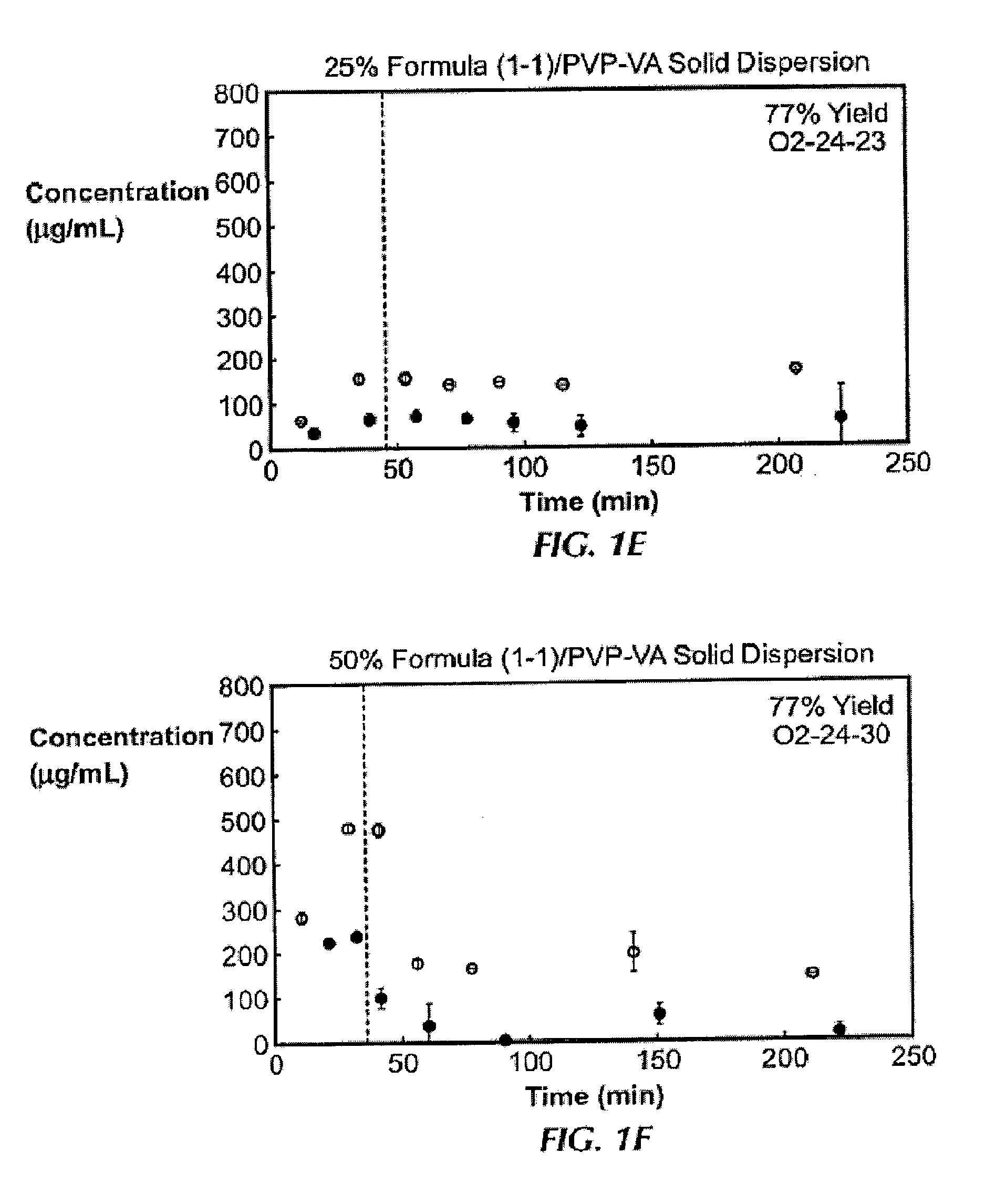Method of treating diffuse large b-cell lymphoma (DLBCL) using a bet-bromodomain inhibitor
a technology of bet-bromodomain and lymphoma cell, applied in the field of treatment, can solve the problems of unsatisfactory characterization of the mechanism of action and relevant affected genes, and no established response predictors
- Summary
- Abstract
- Description
- Claims
- Application Information
AI Technical Summary
Benefits of technology
Problems solved by technology
Method used
Image
Examples
example 1
In Vitro Screening of Solid Dispersions of Compound (1-1)
[0138]Ten solid dispersions were prepared using compound (1-1) and one of five polymers, including hypromellose acetate succinate (HPMCAS-M), hypromellose phthalate (HPMCP-HP55), polyvinylpyrrolidone (PVP), PVP-vinyl acetate (PVP-VA), and Eudragit L100-55, at both 25% and 50% of compound (1-1) loading, for each polymer. Solid dispersions were prepared by a solvent evaporation method, using spray-drying followed by secondary drying in a low-temperature convection oven. The performance of each solid dispersion was assessed via a non-sink dissolution performance test which measured both the total amount of drug and the amount of free drug present in solution over time. Non-sink dissolution was chosen because it best represents the in vivo situation for low soluble compounds. This test included a “gastric transfer” of dispersion from gastric pH (0.1N NaCl, pH 1.0) to intestinal pH (FaFSSIF, pH 6.5) approximately 30 to 40 minutes a...
example 2
In Vivo Screening of Solid Dispersions of Compound (1-1)
[0139]The three most promising solid dispersions of compound (1-1), namely the 25% compound (1-1) in PVP, 25% compound (1-1) in HPMCAS-MG, and 50% compound (1-1) in HPMCAS-M dispersions, were prepared at larger scale for in vivo studies. Each formulation was assessed in the in vitro dissolution test described in Example 1. To ensure that these dispersions were both amorphous and homogeneous, each dispersion was assessed by powder x-ray diffraction (PXRD) and modulated differential scanning calorimetry (mDSC). Additionally, to understand the effect of water on the glass transition temperature (Tg) for each dispersion, mDSC was performed on samples first equilibrated at a set relative humidity (i.e., 25%, 50%, and 75% RH) for at least 18 hours. [Water can act as a plasticizer for solid dispersions and the hygroscopicity of the system due to the active compound or polymer can affect the amount of water uptake by these systems.]
[01...
example 3
Preparation and Clinical Use of Capsules Containing a Solid Dispersion of Compound (1-1)
[0142]A gelatin capsule of 10 mg strength was prepared for initial clinical studies in patients with hematologic malignancies. Based on results of in vitro and in vivo testing of solid dispersions of compound (1-1), as described in Examples 1 and 2, a 50% compound (1-1) in HPMCAS-M solid dispersion was selected for capsule development. Capsule development was initiated targeting a fill weight of 190 mg in a size 3 hard gelatin capsule, as this configuration would potentially allow increasing the capsule strength by filling a larger size capsule while maintaining the pharmaceutical composition. Based on experience, four capsule formulations were designed with different amounts of disintegrant and with and without wetting agent. Since all four formulations showed similar disintegration test and dissolution test results, the simplest formulation (without wetting agent and minimum disintegrant) was s...
PUM
| Property | Measurement | Unit |
|---|---|---|
| Tg | aaaaa | aaaaa |
| enantiomeric excess | aaaaa | aaaaa |
| enantiomeric excess | aaaaa | aaaaa |
Abstract
Description
Claims
Application Information
 Login to View More
Login to View More - R&D
- Intellectual Property
- Life Sciences
- Materials
- Tech Scout
- Unparalleled Data Quality
- Higher Quality Content
- 60% Fewer Hallucinations
Browse by: Latest US Patents, China's latest patents, Technical Efficacy Thesaurus, Application Domain, Technology Topic, Popular Technical Reports.
© 2025 PatSnap. All rights reserved.Legal|Privacy policy|Modern Slavery Act Transparency Statement|Sitemap|About US| Contact US: help@patsnap.com



